Product Images Duloxetine
View Photos of Packaging, Labels & Appearance
- image - 43063878
- Figure 1: Kaplan-Meier Estimation of Cumulative Proportion of Patients with Relapse (MDD Study 5) - duloxetine fig1
- fig2 - duloxetine fig2
- Figure 3: Percentage of Patients Achieving Various Levels of Pain Relief as Measured by 24-Hour Average Pain Severity - DPNP-1 - duloxetine fig3
- Figure 4: Percentage of Patients Achieving Various Levels of Pain Relief as Measured by 24-Hour Average Pain Severity - DPNP-2 - duloxetine fig4
- Figure 7: Percentage of Patients Achieving Various Levels of Pain Relief as Measured by 24-Hour Average Pain Severity – CLBP-1 - duloxetine fig5
- Figure 8: Percentage of Patients Achieving Various Levels of Pain Relief as Measured by 24-Hour Average Pain Severity – CLBP-3 - duloxetine fig6
- Figure 9: Percentage of Patients Achieving Various Levels of Pain Relief as Measured by 24-Hour Average Pain Severity – OA-1 - duloxetine fig7
- duloxetine fig8
- duloxetine fig9
- Structure - duloxetine str
Product Label Images
The following 11 images provide visual information about the product associated with Duloxetine NDC 43063-878 by Pd-rx Pharmaceuticals, Inc., such as packaging, labeling, and the appearance of the drug itself. This resource could be helpful for medical professionals, pharmacists, and patients seeking to verify medication information and ensure they have the correct product.
image - 43063878
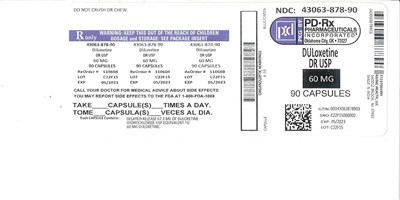
This is a medication package for DuLoxetine, which contains 90 delayed-release capsules of 60mg each of Duloxetine hydrochloride. It is important not to crush or chew the capsules as they need to be ingested whole. The package insert contains dosage and storage information, and patients should call their doctor if they experience any side effects. The product should be kept out of the reach of children. The expiration date is May 2023, and the lot number is c22.15.*
Figure 1: Kaplan-Meier Estimation of Cumulative Proportion of Patients with Relapse (MDD Study 5) - duloxetine fig1
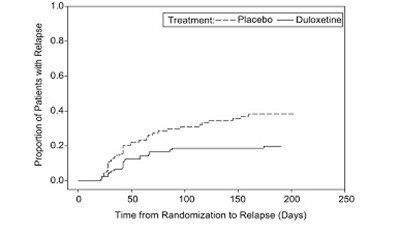
Figure 3: Percentage of Patients Achieving Various Levels of Pain Relief as Measured by 24-Hour Average Pain Severity - DPNP-1 - duloxetine fig3
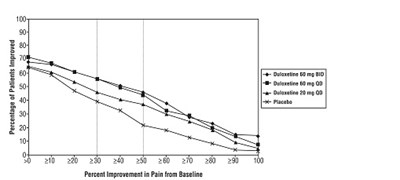
Figure 4: Percentage of Patients Achieving Various Levels of Pain Relief as Measured by 24-Hour Average Pain Severity - DPNP-2 - duloxetine fig4
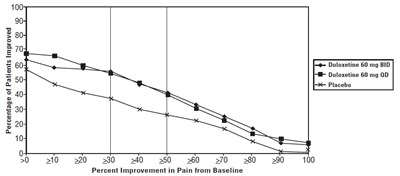
The text appears to be a chart or graph showing the percentage of patients who improved with different treatments, including different doses of Duloxetine and a placebo, based on their level of pain improvement from baseline. The chart shows improvement percentages ranging from 10% to 100%.*
Figure 7: Percentage of Patients Achieving Various Levels of Pain Relief as Measured by 24-Hour Average Pain Severity – CLBP-1 - duloxetine fig5
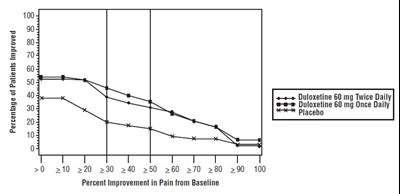
This is a chart that shows the percentage of patients who experienced improvement in pain levels based on the dose of duloxetine (60 mg twice daily or 60 mg once daily) or a placebo. The chart also shows the percent improvement in pain from baseline, ranging from 10% to 80%.*
Figure 8: Percentage of Patients Achieving Various Levels of Pain Relief as Measured by 24-Hour Average Pain Severity – CLBP-3 - duloxetine fig6
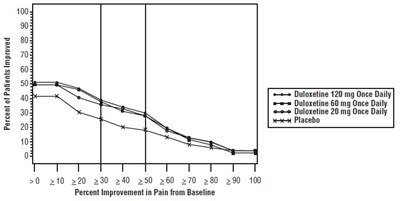
This appears to be a graph or chart showing the percent of patients who improved with different doses of Duloxetine compared to a placebo for pain relief. Unfortunately, without further context, it's not clear what type of pain or condition is being treated.*
Figure 9: Percentage of Patients Achieving Various Levels of Pain Relief as Measured by 24-Hour Average Pain Severity – OA-1 - duloxetine fig7
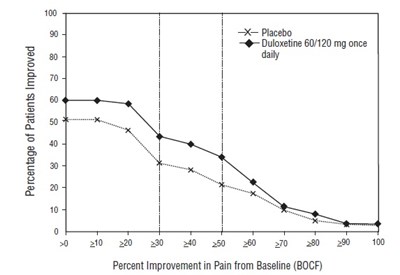
The given text is a graph that shows the percentage of patients improved in terms of pain after taking either a placebo or a dose of duloxetine. The graph displays 100% improvement in all patients who took duloxetine, while the placebo line is missing. The x-axis measures the percentage of pain improvement from baseline, and the y-axis represents the number of patients.*
duloxetine fig9
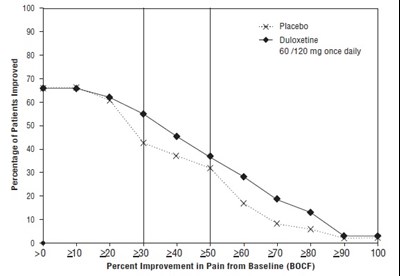
This is a graph presenting the percentage of improvement in pain from baseline for patients taking Placeto and Dulowetine at dosages of 60-120 mg once daily. The X-axis represents the range of percentage improvement from 0 to 100, while the Y-axis represents the number of patients. The graph displays that a higher percentage of patients showed improvement in pain at higher dosages of the medication.*
* The product label images have been analyzed using a combination of traditional computing and machine learning techniques. It should be noted that the descriptions provided may not be entirely accurate as they are experimental in nature. Use the information in this page at your own discretion and risk.


